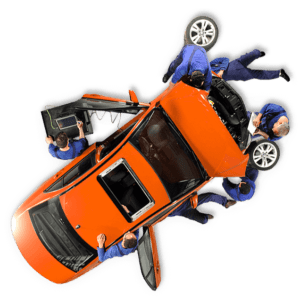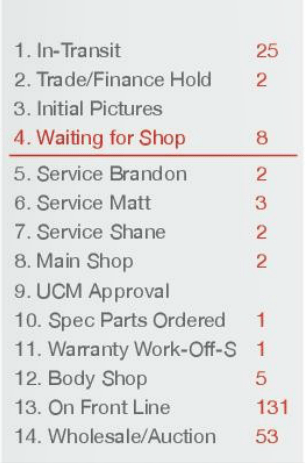15 Jun Used Car Reconditioning Best Practices for Fixed Operations
Ideally, every dealership should be able to manage used car reconditioning at a four- to five-day level, independent of volume. Some exceptional stores are able to operate in a three-day range by keeping service at a four-hour average and detail/photos to an eight-hour average. To consistently and verifiably deliver these metrics, there must be an accurate measurement of all vehicles as they complete each step all along their way to the front line.
The foundation of an efficient used car reconditioning process is based on load balancing cars across two or more dedicated techs. Shown to the right is an example of a workflow from a high-velocity Toyota dealership that sells 165 used/month, averaging just 20 days in stock. Their process is designed to keep their five techs fully loaded, with their next job already dispatched to them so they have the option to swap cars while waiting for a part. With their volume, they are receiving 40 to 50 fresh vehicles per week and are able to get them all to the front line by Friday. This is a highly efficient fixed-ops recon process. But, to be accurate, it did not start out this way. In fact, it took four iterations over the first nine months to arrive at this specific workflow, and was designed and redesigned by their GM and dealer principle several times. Each dealership has a unique set of constraints to work around, but the key is to start with the basics and evolve to your expected level of performance and accountability — two elements that should always go hand-in-hand. Any system that supports this is one that the users — techs, lot managers, vendors or sales — can use with 10 minutes of instruction, and makes their job much easier.
The advantage of this approach is the ability for cars to be re-prioritized and switched out quickly. For example, a department could have an “Express” category for vehicles that are sold; a “Basics” category for those needing emissions, state inspection, oil change, tires/brakes, etc.; and a “Specialty” category for vehicles needing more specialized repairs, such as engine or drive train repairs. Recalls and warranty for “in-house” and “off-brand” has to be part of the fixed-ops balancing. Some dealers use a “heat sheet” generated by their workflow system to triage the problem for cars that need special attention.
One crucial element in performing at this level is the UCM approval. The “best practices”
for this is now only 10 minutes, which is accomplished by texting notifications to the UCM. Approvals are accomplished quickly — and on the spot — through a mobile Website where, to whatever level of detail may be necessary or is listed, the UCM can make a decision without having to stop what he or she is doing, or even having to flip a screen in order to give the go ahead. Getting approvals faster with a used car re conditioning software gets your vehicles on the front line sooner, resulting in additional turns.
conditioning software gets your vehicles on the front line sooner, resulting in additional turns.
The two most important factors in any effective used car reconditioning system are ease of use and balancing the workflow, starting with fixed-operations, where most of your recon cost takes place. If you get this right, a three- to four-day average is within reach.
Dennis McGinn is the founder and CEO of Rapid Recon. He can be contacted at 866.268.3582, or by email at dmcginn@autosuccessonline.com.



Sorry, the comment form is closed at this time.